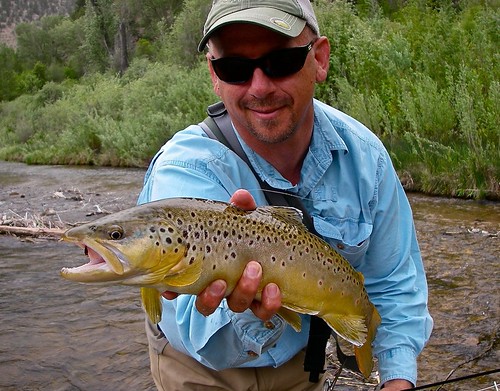Posted by: Larry Kenney
Date: 11/28/11

Do you ever find yourself scratching your head when reading about fly rods, or do you find yourself lost when you hear a couple guys at your club meeting discussing their new rod-building projects? Do you know the difference between the prepreg and the scrim?
Some of the terms that describe fly-rod construction are pretty arcane, so here's a brief glossary from longtime rod-builder Larry Kenney that will help you better understand what goes into making a fly rod and keep up with the conversation when the rod-builders start talking shop. It will also make it easier to understand what makes a new rod technology so new—as in the Helios's "thermpolastic resin in the layup and unidirectional scrim"—and how such a new technology translates into better performance on the water.
Blank: The long, skinny thing—generally tubular—to which the handle, reel seat, guides, and often ugly graphics are added.
Butt section: The bottom, thick section of a rod or blank.
Ferrule: The device by which the sections of a rod or blank are connected.
Fighting butt: The short, cork- or foam-covered extension to the rear of the reel seat, designed to keep the reel out of one’s beer belly when fighting a fish.
Fixed hood: A fixed metal shroud over either the top or the bottom of the reel-seat cylinder into which one end of the reel seat is placed.
Layup: The specific way in which patterns of composite prepreg are layered around a mandrel. Specific layups may include different fibers (graphite and boron, graphite and fiberglass), different orientations (unidirectional, woven, or filament-wound) or a combination of fibers and fiber orientations—all designed to produce specific characteristics of flex, stiffness, and durability.
Locking ring: The nut that puts pressure against the sliding hook to keep the reel securely locked in place.
Material: The fibers (graphite, fiberglass, Kevlar, boron, or some combination of them) that do the work—supporting the load of the fly line or pulling on a fish. Most contemporary rods are fabricated principally from fibers that run unidirectionally along the length of the rod, although many rods also make use of fibers running around or at an angle to the unidirectional fibers, in order to provide additional strength.
Prepreg: The fabric created by impregnating the material with resin. The prepreg is cut into “flags,” which are rolled around the mandrel(s).

A worker at the Orvis rod shop in Manchester, Vermont, prepares some prepreg,
which will be cut into "flags" and rolled onto a mandrel.
photo by Tim Bronson
Reel seat: The threaded metal cylinder on which the reel is secured to the rod.
Resin: The matrix that holds the fibers together. Most modern rods are fabricated with thermoplastic epoxy resins.
Scrim: A lightweight fabric of fiberglass or graphite that forms a lining under the principal fibers and which aids in working with the material when it is rolled around a mandrel. Some scrims are woven, and some aren’t. Scrim fibers that go around, rather than up and down, the blank also add “hoop strength” to the finished product.
Sliding hood: A sliding metal shroud that slides over the end of the reel seat that isn’t under the fixed hood.
Taper: A term often used synonymously with “action” to describe the way a rod performs. Tapers in which the difference in diameter between butt and tip were relatively great (“fast” tapers) produced stiff-butted, light-tipped, fast-action rods. Slow-action rods came from blanks in which the difference between butt and tip diameters was smaller. The taper of a tubular rod is determined by the shape of the mandrel(s) around which it is fabricated. A rod’s action is, in large part, by that taper, but also by the material(s), the layup, the number of section a ferrules, and by the weight and placement of guides and wraps—a complicated alchemy to which this brief overview does benign disservice.
Tip section: The section of a rod or blank farthest from the butt section.
Larry Kenney is a well-known fly-rod builder who lives in San Francisco.







 Drilling is likely to begin in the Delaware River Watershed - the source of drinking water for 15.6 million people - in a matter of weeks or months
Drilling is likely to begin in the Delaware River Watershed - the source of drinking water for 15.6 million people - in a matter of weeks or months 
 I'm writing to you today because as concerned residents of the Catskills, we cannot stand by and watch as our water, our air and our health are threatened. We cannot afford to take a backseat and watch as our vibrant lands and communities are turned into an industrialized fracking site. The price that each of us will pay is too great. We have only to look as far as our neighbors in Pennsylvania to see what a fracked future will look like for us.
I'm writing to you today because as concerned residents of the Catskills, we cannot stand by and watch as our water, our air and our health are threatened. We cannot afford to take a backseat and watch as our vibrant lands and communities are turned into an industrialized fracking site. The price that each of us will pay is too great. We have only to look as far as our neighbors in Pennsylvania to see what a fracked future will look like for us.